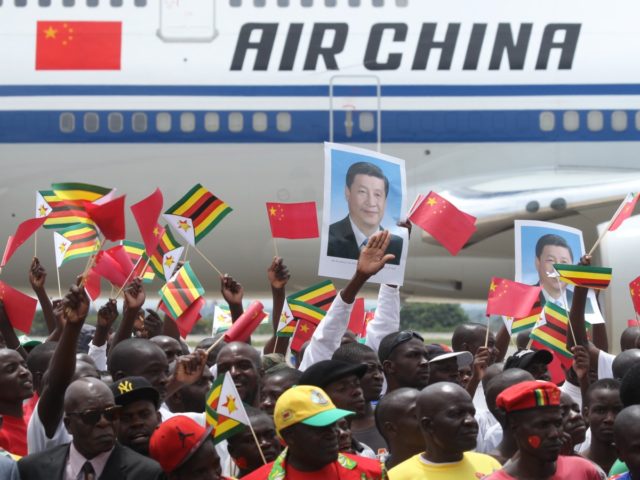China’s state-run Xinhua news service reported on Sunday that medical teams dispatched to help combat the coronavirus epidemic in Zimbabwe are bringing “traditional Chinese medicine” along with modern equipment.
China is brazenly attempting to use the Wuhan virus as leverage to dominate health care across countries with poor medical infrastructure by creating a “Health Silk Road” that parallels its New Silk Road trade and infrastructure program, more commonly known as the Belt and Road Initiative (BRI).
Xinhua’s report said the Chinese medical group was already in Zimbabwe, with a traditional medicine practitioner on the roster, and received some emergency “remote training on tackling Covid-19 provided by national and provincial health authorities in China” when the pandemic broke out:
Jiang Zhichao, head of the 17th Chinese medical team to Zimbabwe, had imagined many possibilities of public heath issues when he arrived in the country last year. But he has never expected to confront anything like the novel coronavirus disease, which has led to more than 146 000 deaths worldwide.
In Zimbabwe, the number of COVID-19 cases has risen to 24 after a new case was recorded in Harare on Thursday, the country’s Ministry of Health and Child Care said Friday morning. The tally included two recoveries and three deaths.
A Traditional Chinese Medicine (TCM) practitioner in a hospital in central China’s Hunan Province, Jiang has been keen to promote and practice TCM overseas. Last year, he signed up for the medical team dispatched to Africa.
Zimbabweans, thousands of miles away, seemed unaffected by the COVID-19 outbreak in China in February and early March, when few people on the street wore masks, including doctors and nurses. It was not until March 20, when the authorities announced the first confirmed case of COVID-19, that the citizens began to realize the virus was hitting every corner of the world, including their country, Jiang said.
“The outbreak came as a big surprise to us, since we are planning to give full play to our know-how in the African country,” said Jiang, who arrived in Zimbabwe along with nine other members in June.
The Council on Foreign Relations (CFR) noted that after floating the idea in 2017 without much follow-up, China began using Health Silk Road rhetoric more aggressively after Chinese dictator Xi Jinping dropped the phrase in a phone conversation with Prime Minister Giuseppe Conte of Italy in March. Italy is the only G7 country participating in BRI at the moment, and it was the scene of an especially deadly coronavirus outbreak.
Other Chinese officials began talking up the Health Silk Road after Xi’s call with Conte, seeking to use the pandemic in “ways that may be advantageous to China in this moment of crisis,” as the CFR put it.
“Like the BRI itself, the Health Silk Road is not a well-defined term, and it is not clear which of China’s activities fall under the banner. According to state media, the Health Silk Road includes mutual medical aid between China and Italy to ‘battle the COVID-19 pneumonia together,’ as well as any activity that might support China’s vision of ‘a new approach for perfecting global public health governance.’ This could certainly be expanded to include China’s activities with other countries,” the CFR noted.
The CFR expected China to use the Health Silk Road as a way of deflecting global anger over Beijing’s role in unleashing the coronavirus pandemic, and perhaps as a way to revitalize the original New Silk Road economic project, whose supply lines were compromised by pandemic travel restrictions, lockdowns, economic crises, and apprehension about Chinese workers bringing more infections with them.
Forbes quoted analysts in March who saw the Health Silk Road as part of Beijing’s “charm offensive” in the wake of the pandemic, noting that some of China’s medical supply shipments were very obviously staged as propaganda events.
Forbes noted that health care fits easily into China’s strategy of using BRI to increase its political, economic, and cultural influence in developing and distressed nations:
If we look back through the history of the initiative we see China stepping into countries like Greece, Italy and Sri Lanka and trying to rebuild their shattered economic realities…in exchange for a bigger footprint for Chinese companies, more leverage for Beijing, and, of course, piles of debt. We only need to remember that China’s takeover of Greece’s Pireaus Port was a direct result of the 2008 financial crisis.
[Center for Strategic and International Studies analyst Jonathan] Hillman says that China’s moves during the pandemic are “orchestrating a Belt and Road echo chamber. Recipients need assistance and they’re praising Beijing’s response [to the outbreak] to get it. China has been able to get statements of praise from Pakistan, Serbia, Ethiopia and Italy—all countries it has cultivated political and economic ties with through BRI.”
The World Health Organization (W.H.O.) applauded China’s Health Silk Road idea when it was first proposed in 2017. Analysts speculated the Health Silk Road could be China’s Plan B for dominating global health care if WHO collapses, or is purged of Chinese Communist Party influence.
National Bureau of Asian Research fellow Nadege Rolland described the Health Silk Road as “the clearest example of the fact that BRI is not about infrastructure construction, but a broader effort to redraw the world according to Beijing’s preferred design.”

COMMENTS
Please let us know if you're having issues with commenting.